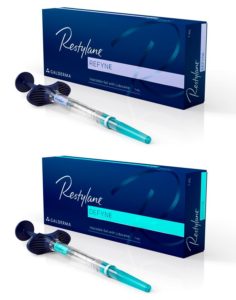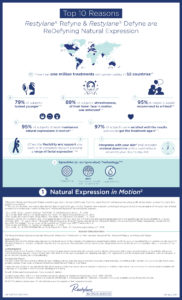In mid-September, DTC Perspectives spoke with Alisa Lask, the VP and General Manager of Aesthetic & Corrective Business Unit from Galderma, about the evolution of their digital marketing. “Digital has had a really powerful impact on the aesthetics brands,” she noted. Galderma’s aesthetics business unit is already seeing a large usage of their various digital assets, from materials at the point of care to their digital-only ASPIRE loyalty program. Another digital victory for the company is their Facebook Restylane® page, which after launching just a few months ago, is already outperforming competitors in the space.
Lask shared that, over the past few years, another evolution they have witnessed is how many Health Care Professionals (HCPs) are now using social media and how much they are using it. Utilizing a variety of platforms, including Facebook, Instagram, and Snapchat, HCPs are interacting both with Galderma and with patients. This uncovered a big opportunity for Galderma to invest in digital to create their own assets for their partnering HCPs, many of whom have around 10,000-15,000 patients in their databases on average. These materials not only educated the HCPs, but allowed those HCPs to share them with their staff and consumers in the office or waiting room as well.
Innovations to set a new standard
 Galderma wanted to make the most of the opportunities digital affords, making one of their approaches an innovative use of video. Aesthetics products, such as Restylane®, lend themselves quite well to digital media. As the industry transitions away from still Before & After photos, Lask explained they created videos that would showcase the natural results of their treatments. “When we launched our two new products, Restylane® Refyne and Restylane® Defyne, earlier this year, the whole philosophy behind those products was that they were designed to be flexible in animation and in expression in motion for natural-looking results.”
Galderma wanted to make the most of the opportunities digital affords, making one of their approaches an innovative use of video. Aesthetics products, such as Restylane®, lend themselves quite well to digital media. As the industry transitions away from still Before & After photos, Lask explained they created videos that would showcase the natural results of their treatments. “When we launched our two new products, Restylane® Refyne and Restylane® Defyne, earlier this year, the whole philosophy behind those products was that they were designed to be flexible in animation and in expression in motion for natural-looking results.”
When sending out their first product samples to HCP offices, a video would play when the box was opened, with four different videos being included in each one. With people clamoring to obtain the sample boxes so they could view and share the videos, Galderma took their marketing to another level: text message video. If an individual, HCP or consumer, texted certain phrases to a designated number, they would receive four to five corresponding videos. Of the videos offering through the sample boxes and text message, Galderma developed real Before & After footage, digital animation of the mechanism in action, and the background and science of the XpresHAn™ technology. (XpresHAn™ is derived from the three components it comprises: X = Crosslinking; pres = Pressing gels through mesh for calibration; and HA = Hyaluronic Acid.)
Another innovative approach the aesthetics teams took was through their ASPIRE loyalty program, which is 100% digital communications. Consumers can receive educational emails, digital coupons towards products, and sweepstake offers electronically. Meanwhile, doctors can log onto a special portal within ASPIRE to obtain Galderma assets, find out which of their patients have redeemed Galderma offers or promotions, or track which of their patients may have lapsed in their treatment so they can provide necessary follow ups. Taking a digital only approach has not had a negative impact – Galderma’s response rates are just as good, if not better, according to Lask.
With an obvious expected increase in spending in digital and social media in the future, she said, “Having a social and digital strategy is status quo. I think the real focus is more on how digital and social are going to change, so we have to evolve our spending and budget.” With the challenge being adjusting investments, Lask added, “we all have to learn how to be a lot more nimble so we’re allowed to pivot quickly as the digital and social channels change.”
Ensuring relevance

Historically, pharma has often lagged behind other industries when incorporating digital or social media into their marketing due to a lack of clear FDA guidance. “There is no doubt that digital is changing faster than any of these regulations can keep up,” Lask noted, so they make sure to partner closely with their legal and regulatory teams from start and every step along the way. Consumers expect brands today to be “honest and candid, but [also] relevant to them.” Balancing such expectations with “the very important fact that we want safe and effective usage of our products … can be challenging and we’re learning as we go in many instances,” she said. Thus, they make sure their assets center on the important safety information, but present it in a consumerized way that people find engaging.
Lask stressed the importance of relevance when developing their educational and branded efforts: “We make sure first that it is relevant for the consumer. There is just so much noise out there, and if we are creating irrelevant material, you can almost guarantee that it is going to be skipped or not used. Then we put our focus on, what is the brand’s essence of our Galderma aesthetic product? It goes back to being honest, candid, and really being true to what we stand for.”
Galderma’s aesthetics brands employ both educational and branded tactics, depending on what is more appropriate at the time. “It’s a combination between education and branded marketing; we feel like you can’t do one without the other,” she said. With these treatments being elective, getting patients to be inspired by outcomes and addressing their primary concern – looking natural – is step one, she explained. Here, educational marketing leads the way. Branded marketing comes into play next to ensure the patient chooses their products, not a competitor’s.
Looking ahead
When preparing future plans, Lask has spotlighted three strategic areas, each one connected in a different way to improving access to education and information. One of the first things Galderma is keeping an eye on are websites such as Yelp or HCP reviews – anywhere that consumers can get engaged with how they find HCPs. She explained that, in the aesthetics market, those are very important to how consumers can figure out where they go for a treatment. Another area of watch for the team is around platforms such as RealSelf.com, which is a community-driven website providing information and research, reviews, and rankings for aesthetic medicines and cosmetic treatments. Lask likened it to the Trip Advisory of aesthetics.
The last key concentration is around retail pop up clinics, she said. It is empowering for consumers to have such access to information and freedom from scheduling appointments. But as a marketer, it provides other challenges – primarily, how do marketers find these places and then also ensure consumers are receiving their materials and relevant messages? Another barrier Lask found is that many of these retail pop up clinics, which are often owned by large corporations now, don’t usually want company branding or materials. She identifies this as a problem that will need to be solved in the future: “how to make sure that we’re able to touch the consumer in those offices as well?”
“The landscape is always changing, but that’s what is fun and exciting about it,” she stated. With more than two million women using aesthetic products currently and another 15 – 20 million more in the US alone who are interested in them, Lask said it is educating and providing them with information so they “really understand outcomes, what they can look like, and what’s possible.”



